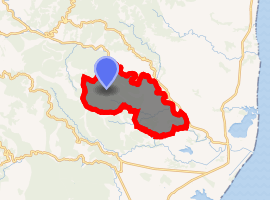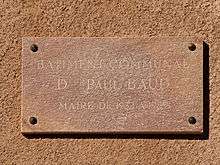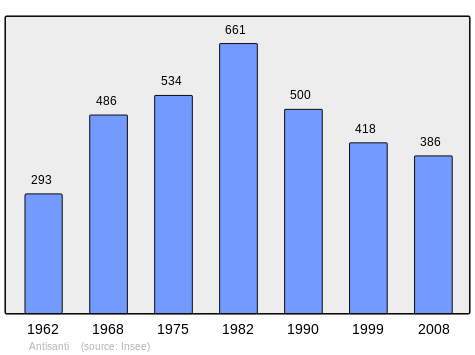Antisanti
Antisanti (in Corsican Antisanti, pronounced [ɑ̃ŋ.ti.ˈzɑ̃ːŋ.ti]) is a commune in the Haute-Corse (Upper Corsica) department of France on the island of Corsica.
Antisanti | |
|---|---|
 The church and surrounding buildings in Antisanti | |
Location of Antisanti 
| |
 Antisanti  Antisanti | |
| Coordinates: 42°10′04″N 9°20′48″E | |
| Country | France |
| Region | Corsica |
| Department | Haute-Corse |
| Arrondissement | Corte |
| Canton | Ghisonaccia |
| Government | |
| • Mayor (2008–2020) | Antony Alessandrini |
| Area 1 | 47.95 km2 (18.51 sq mi) |
| Population (2017-01-01)[1] | 546 |
| • Density | 11/km2 (29/sq mi) |
| Time zone | UTC+01:00 (CET) |
| • Summer (DST) | UTC+02:00 (CEST) |
| INSEE/Postal code | 2B016 /20270 |
| Elevation | 5–780 m (16–2,559 ft) (avg. 750 m or 2,460 ft) |
| 1 French Land Register data, which excludes lakes, ponds, glaciers > 1 km2 (0.386 sq mi or 247 acres) and river estuaries. | |
The inhabitants of the commune are known as Antisantais or Antisantaises.[2]
Geography
Antisanti is a landlocked commune on the eastern side of Corsica overlooking the eastern plain of the island some 80 km south of Bastia and 12 km west by north-west of Aléria. It belonged to the ancient Pieve of Rogna and is now part of the Rogna in La micro-region located on the right bank of the Tavignano extending from Vivario to the plain. Access to the commune is by the minor road D43 from Aléria in the east passing through the heart of the commune and the village before continuing west to join the D143 south-east of Santo-Pietro-di-Venaco. There is also a connecting road to the D343 near Vezzani. National Highway N200 passes along the eastern and northern borders but there is no access to the commune.
The west of the commune is rugged and heavily forested while the eastern half is on the plain with mostly farmland although still having significant forested areas.
The northern and eastern borders of the commune are formed by the Tavignano river with a large tributary flowing west through the centre of the commune to join it on the eastern border.[3]
Neighbouring communes and villages[3]
History
In 1770 Antisanti was one of the least populated communes in the Piève of Rogna.[4]
With the French Revolution of 1789 the Pieve of Sorba became the Canton of Vezzani in the district of Bastia.
Since 1954 Antisanti has been part of the Canton of Vezzani along with the communes of Aghione, Casevecchie, Noceta, Pietroso, Rospigliani, and Vezzani.[5]
Administration

List of Successive Mayors[6]
| From | To | Name | Party | Position |
|---|---|---|---|---|
| 1953 | 1989 | Paul Baud[7] | ||
| 2001 | 2020 | Anthony Alessandrini |
(Not all data is known)
Demography
In 2009 the commune had 388 inhabitants. The evolution of the number of inhabitants is known from the population censuses conducted in the commune since 1793. From the 21st century, a census of communes with fewer than 10,000 inhabitants is held every five years, unlike larger towns that have a sample survey every year.[Note 1]
| 1793 | 1800 | 1806 | 1821 | 1831 | 1836 | 1841 | 1846 | 1851 |
|---|---|---|---|---|---|---|---|---|
| - | 379 | 373 | 474 | 575 | 649 | 664 | 795 | 775 |
| 1856 | 1861 | 1866 | 1872 | 1876 | 1881 | 1886 | 1891 | 1896 |
|---|---|---|---|---|---|---|---|---|
| 779 | 681 | 687 | 801 | 821 | 777 | 795 | 819 | 827 |
| 1901 | 1906 | 1911 | 1921 | 1926 | 1931 | 1936 | 1946 | 1954 |
|---|---|---|---|---|---|---|---|---|
| 897 | 900 | 823 | 728 | 708 | 655 | 613 | 530 | 589 |
| 1962 | 1968 | 1975 | 1982 | 1990 | 1999 | 2006 | 2009 | - |
|---|---|---|---|---|---|---|---|---|
| 493 | 486 | 534 | 661 | 500 | 418 | - | 388 | - |

Economy
Antisanti markets 40% of the national production of Clementines from its vast orchards.
Cultural and heritage
Civil architecture
- A War Memorial on the side facade of the parish church.
Religious heritage
- The 'Parish church of Saint-Pierre-aux-Liens. Built in 1894, this small baroque church was remodeled and enlarged in 1944.
 Town hall and church
Town hall and church Parish church
Parish church Interior of the church
Interior of the church Ornate ceiling of the nave
Ornate ceiling of the nave
Notable people linked to the commune
- Georges Benedetti, French politician, born in Antisanti on 29 July 1930
See also
External links
- Antisanti official website
- Antisanti on Lion1906
- Antisanti on Géoportail, National Geographic Institute (IGN) website (in French)
Notes and references
Notes
- At the beginning of the 21st century, the methods of identification have been modified by Law No. 2002-276 of 27 February 2002, the so-called "law of local democracy" and in particular Title V "census operations" allows, after a transitional period running from 2004 to 2008, the annual publication of the legal population of the different French administrative districts. For communes with a population greater than 10,000 inhabitants, a sample survey is conducted annually, the entire territory of these communes is taken into account at the end of the period of five years. The first "legal population" after 1999 under this new law came into force on 1 January 2009 and was based on the census of 2006.
References
- "Populations légales 2017". INSEE. Retrieved 6 January 2020.
- Inhabitants of Haute-Corse (in French)
- Google Maps
- Antisanti website Archived 2013-06-27 at the Wayback Machine (in French)
- ADECEC - CORSICA: Elements for a dictionary of proper names Archived 2012-01-26 at the Wayback Machine (in French)
- List of Mayors of France
- Commemorative Plaque
| Wikimedia Commons has media related to Antisanti. |